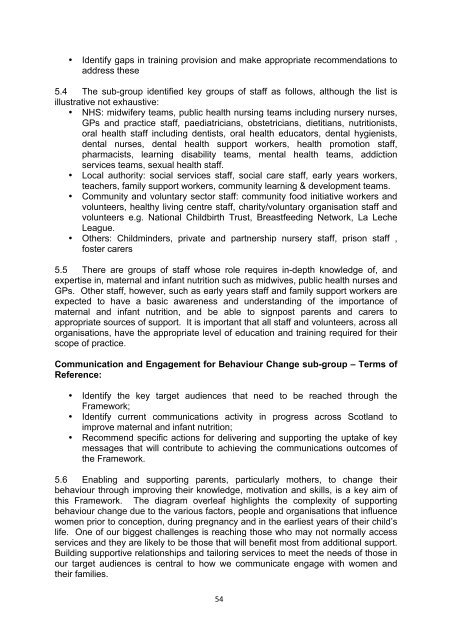Improving Maternal and Infant Nutrition: A Framework for Action
Improving Maternal and Infant Nutrition: A Framework for Action
Improving Maternal and Infant Nutrition: A Framework for Action
You also want an ePaper? Increase the reach of your titles
YUMPU automatically turns print PDFs into web optimized ePapers that Google loves.
• Identify gaps in training provision <strong>and</strong> make appropriate recommendations toaddress these5.4 The sub-group identified key groups of staff as follows, although the list isillustrative not exhaustive:• NHS: midwifery teams, public health nursing teams including nursery nurses,GPs <strong>and</strong> practice staff, paediatricians, obstetricians, dietitians, nutritionists,oral health staff including dentists, oral health educators, dental hygienists,dental nurses, dental health support workers, health promotion staff,pharmacists, learning disability teams, mental health teams, addictionservices teams, sexual health staff.• Local authority: social services staff, social care staff, early years workers,teachers, family support workers, community learning & development teams.• Community <strong>and</strong> voluntary sector staff: community food initiative workers <strong>and</strong>volunteers, healthy living centre staff, charity/voluntary organisation staff <strong>and</strong>volunteers e.g. National Childbirth Trust, Breastfeeding Network, La LecheLeague.• Others: Childminders, private <strong>and</strong> partnership nursery staff, prison staff ,foster carers5.5 There are groups of staff whose role requires in-depth knowledge of, <strong>and</strong>expertise in, maternal <strong>and</strong> infant nutrition such as midwives, public health nurses <strong>and</strong>GPs. Other staff, however, such as early years staff <strong>and</strong> family support workers areexpected to have a basic awareness <strong>and</strong> underst<strong>and</strong>ing of the importance ofmaternal <strong>and</strong> infant nutrition, <strong>and</strong> be able to signpost parents <strong>and</strong> carers toappropriate sources of support. It is important that all staff <strong>and</strong> volunteers, across allorganisations, have the appropriate level of education <strong>and</strong> training required <strong>for</strong> theirscope of practice.Communication <strong>and</strong> Engagement <strong>for</strong> Behaviour Change sub-group – Terms ofReference:• Identify the key target audiences that need to be reached through the<strong>Framework</strong>;• Identify current communications activity in progress across Scotl<strong>and</strong> toimprove maternal <strong>and</strong> infant nutrition;• Recommend specific actions <strong>for</strong> delivering <strong>and</strong> supporting the uptake of keymessages that will contribute to achieving the communications outcomes ofthe <strong>Framework</strong>.5.6 Enabling <strong>and</strong> supporting parents, particularly mothers, to change theirbehaviour through improving their knowledge, motivation <strong>and</strong> skills, is a key aim ofthis <strong>Framework</strong>. The diagram overleaf highlights the complexity of supportingbehaviour change due to the various factors, people <strong>and</strong> organisations that influencewomen prior to conception, during pregnancy <strong>and</strong> in the earliest years of their child’slife. One of our biggest challenges is reaching those who may not normally accessservices <strong>and</strong> they are likely to be those that will benefit most from additional support.Building supportive relationships <strong>and</strong> tailoring services to meet the needs of those inour target audiences is central to how we communicate engage with women <strong>and</strong>their families.
















